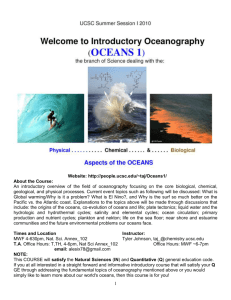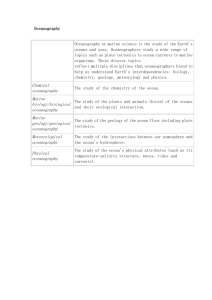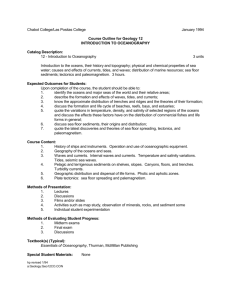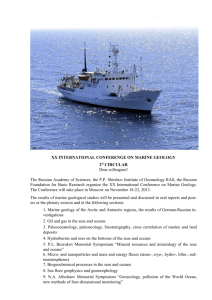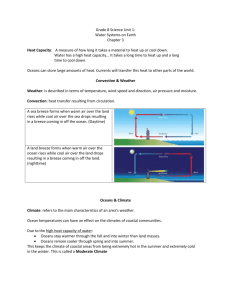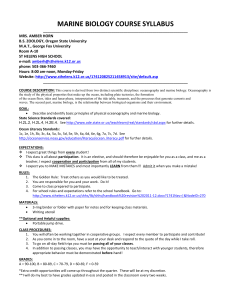The Endless Voyage
advertisement
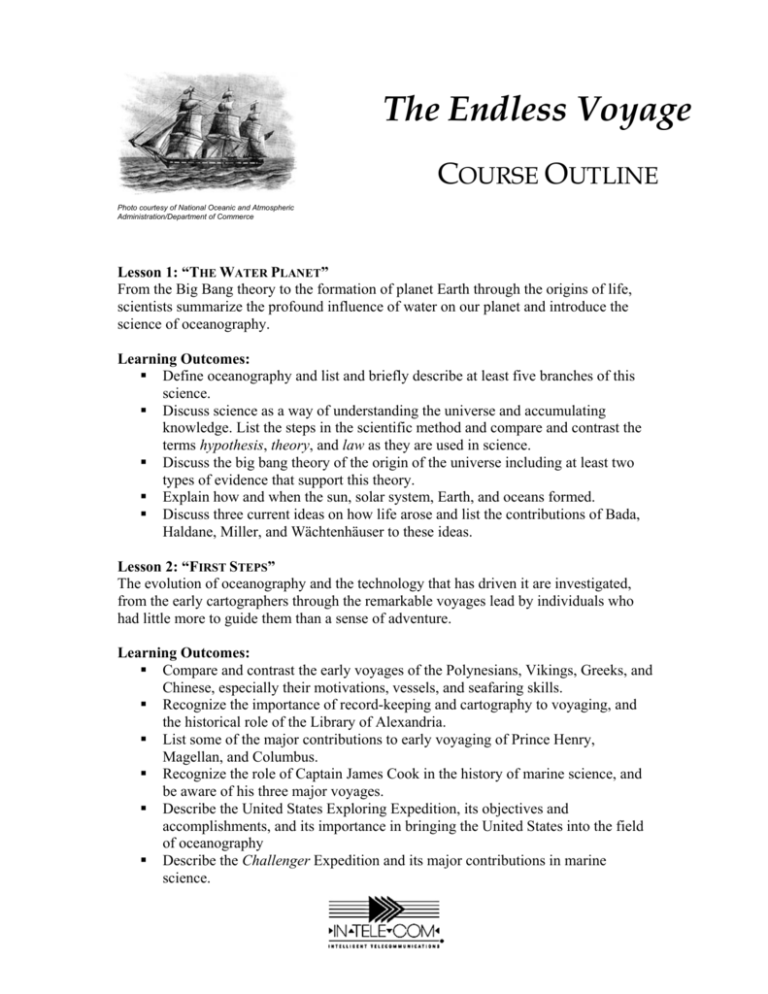
The Endless Voyage COURSE OUTLINE Photo courtesy of National Oceanic and Atmospheric Administration/Department of Commerce Lesson 1: “THE WATER PLANET” From the Big Bang theory to the formation of planet Earth through the origins of life, scientists summarize the profound influence of water on our planet and introduce the science of oceanography. Learning Outcomes: Define oceanography and list and briefly describe at least five branches of this science. Discuss science as a way of understanding the universe and accumulating knowledge. List the steps in the scientific method and compare and contrast the terms hypothesis, theory, and law as they are used in science. Discuss the big bang theory of the origin of the universe including at least two types of evidence that support this theory. Explain how and when the sun, solar system, Earth, and oceans formed. Discuss three current ideas on how life arose and list the contributions of Bada, Haldane, Miller, and Wächtenhäuser to these ideas. Lesson 2: “FIRST STEPS” The evolution of oceanography and the technology that has driven it are investigated, from the early cartographers through the remarkable voyages lead by individuals who had little more to guide them than a sense of adventure. Learning Outcomes: Compare and contrast the early voyages of the Polynesians, Vikings, Greeks, and Chinese, especially their motivations, vessels, and seafaring skills. Recognize the importance of record-keeping and cartography to voyaging, and the historical role of the Library of Alexandria. List some of the major contributions to early voyaging of Prince Henry, Magellan, and Columbus. Recognize the role of Captain James Cook in the history of marine science, and be aware of his three major voyages. Describe the United States Exploring Expedition, its objectives and accomplishments, and its importance in bringing the United States into the field of oceanography Describe the Challenger Expedition and its major contributions in marine science. Chronicle the rise of land-based oceanographic institutions, from the early beginnings in Naples and Monaco to the major facilities now operating in the United States. List the disciplines in which marine research is being done today, as it relates to recent advances in data gathering and technology. Lesson 3: “MAKING THE PIECES FIT” In 1965, John Tuzo Wilson supplied the final piece of the puzzle necessary to the development of the plate tectonics paradigm, which had its roots in Wegener’s 1912 theory of continental drift. Learning Outcomes: Compare and contrast the classification of Earth's layers based on chemical composition versus their classification based on physical properties. Describe the layered structure of Earth and understand how the structure was determined through the study of seismic waves. Understand Wegener’s evidence for the theory of continental drift and how this theory was received. Explain the concepts of buoyancy and isostatic equilibrium and their relationship to continental drift. Understand the source of convection and the role it plays in plate tectonics. Describe the roles of Benioff and Wadati, Hess and Dietz, Wilson, and the R/V Glomar Challenger in formulating the paradigm of plate tectonics. Compare and contrast the terms continental drift, seafloor spreading, and plate tectonics. Explain the evidence, both direct and indirect, for plate tectonic theory. Lesson 4: “WORLD IN MOTION” Though many questions remain unanswered, the evidence for plate tectonics is found virtually everywhere it is sought and continues to mount today. Polar wandering and the characteristics of plate boundaries, hot spots, and earthquakes continue the study of plate tectonics. Learning Outcomes: Describe the three major types of plate boundaries and discuss specific examples of each. Describe the formation, movement, and fate of the Hawaiian Ridge and Emperor Seamounts and explain how these features support the theory of plate tectonics. Discuss the formation of guyots and terranes and how each is related to tectonic movements. Compare and contrast deep and shallow earthquakes and describe the WadatiBenioff Zone. Explain how the patterns of paleomagnetism, seafloor age, and sediment thickness contribute to an understanding of tectonic theory. Summarize the major types of evidence that support the theory of plate tectonics and list at least five significant unanswered Lesson 5: “OVER THE EDGE” Bathymetry is the study of the topography of the ocean floor. This lesson examines the seafloor from the continental margins to the abyssal plain, trenches, and hydrothermal vents with their newly-discovered biota. New technology and techniques continue to expand access to seabed studies. Learning Outcomes: Discuss the history of bathymetry from the early voyagers to the scientists of today. Understand the modern techniques and technologies (both shipboard and satellite) used to describe and study the ocean floor and the variety of speciallydesigned and instrumented vessels. Describe the features and boundaries characterizing the continental shelf, shelf break, slope, and rise. List the various types of continental margins and their relationships to the plate margins. Compare and contrast manned and unmanned undersea research vessels regarding their basic construction, operation, and capabilities. Explain Earth’s oceanic ridge system and how it relates to the lithospheric plates. Understand the hydrothermal vent phenomenon—how it works, its biological and physical aspects, and its potential for research and exploitation. Describe the abyssal plain—its extent and boundaries, relief features, and sources of sediment. Lesson 6: “THE OCEAN'S MEMORY” This lesson examines marine sediments, which provide an important record of an ocean basin’s history. The study of marine sediments employs the same techniques devised by terrestrial geologists, and is of commercial and scientific interest across many disciplines. Learning Outcomes: Characterize the distribution of the major seafloor sediment types, and how they can be associated with the more sediment-free relief features. Discuss the role of sediments in constructing a history of recent seafloor formation. List and describe the major criteria used to classify marine sediments. Compare and contrast the sediments of the continental margins and those of the deep-sea floor. Understand the biological and chemical Discuss the growing commercial interest in marine sediments, including their potential as a resource and recovery methods. Characterize the technologies involved in seafloor sediment study: locating, profiling, recovering, laboratory analysis. Understand the basic processes involved in the formation of oil and gas in marine sediments. Explain how knowledge of marine sediments can aid in describing Earth’s historical climatic changes and magnetic field orientation. Lesson 7: “IT'S IN THE WATER” The chemistry of water and its unique physical properties and behavior are studied, as well as the temperature, density, and salinity of the ocean’s water. Also considered is the profound impact of the ocean on global temperatures. Learning Outcomes: Describe the structure and characteristics of water molecules and explain how these contribute to the global thermostatic effects of water on Earth’s climate. Describe the factors that regulate the density of seawater and explain the nature and importance of the thermohaline circulation. Describe the sources, composition, and measurement of the ocean’s salinity and outline the colligative properties of water. Discuss the principle of constant proportions and compare, contrast, and give examples of conservative and non-conservative constituents of seawater. Compare and contrast the general distribution, concentration, and roles of dissolved carbon dioxide and dissolved oxygen in the ocean. Explain the relationship between carbon dioxide and the greenhouse effect and the interplay of oceanic and atmospheric carbon dioxide in global warming. Explain why some scientists believe that adding iron to the oceans could affect atmospheric carbon dioxide and global warming. Lesson 8: “BENEATH THE SURFACE” The ocean is a dynamic structure. This lesson explores the stratification, movement, and surface conditions of that structure as well as how light and sound are affected by the ocean environment. Learning Outcomes: Describe the general density stratification of the oceans and explain why it exists and how it differs in tropical, temperate, and polar oceans. Compare and contrast the euphotic, disphotic, and aphotic zones of the ocean. Compare and contrast the following ocean zones: epipelagic, mesopelagic, bathypelagic, abyssopelagic, and hadopelagic. Discuss how the quantity and wavelength of light changes as it passes through seawater and list some ways this affects marine life. Draw a profile illustrating how the speed of sound changes with depth in the ocean. Explain how these changes create the sofar layer and the shadow zone. Explain how and why sound is used to study global ocean temperatures. Explain what sonar is and describe how humans use it. Lesson 9: “GOING TO EXTREMES” Through a comparative study of the polar and tropic oceans, students are given the opportunity to integrate and apply the facts and principles presented to this point in the course. Learning Outcomes: Define primary production and compare and explain the patterns of production in polar and tropical oceans. Explain the structure of coral animals and coral reefs and explain why coral reefs are much more common on the western sides of oceans than on the eastern sides. Define biodiversity; compare and contrast biodiversity in polar oceans and on coral reefs. Compare and contrast the Arctic and Antarctic polar regions; compare and contrast western tropical oceans and eastern tropical oceans. Explain the symbiotic relationship between zooxanthellae and the coral polyps they inhabit. List and give examples of several ways organisms cope with the long dark season of polar oceans. Discuss several uses, abuses, and problems specific to coral reefs and to polar ecosystems. Lesson 10: “SOMETHING IN THE AIR” The interaction of the ocean, the atmosphere, and the land form an inseparable system. The atmospheric composition, properties, and circulation of this system as well as the Coriolis Effect, wind patterns, and air masses are studied in this lesson. Learning Outcomes: Understand the molecular composition of Earth’s lower atmosphere, the fluctuating role of water vapor, and how all of this influences air’s density. Describe the phenomenon of convection and how it affects the movement of air over Earth’s surface. Explain the concept of Earth’s “climate system” as it relates to the whole Earth system—ocean, atmosphere, and land. Understand the basic sequence of events involved in Hurricane Mitch, and why it is used as an example of how the power of Earth’s climate system affects the human population. Explain the role of the sun’s energy in atmospheric circulation, recognizing the absorption/radiation/re-radiation concept and the varying amounts of Earth’s heat budget involved. List and characterize the four major types of atmospheric convection cells— Hadley, Ferrel, Polar, and Walker. Understand the Coriolis Effect and how it influences atmospheric conditions. Describe the various common global wind and storm patterns—where they form, their basic characteristics, and how they are named. Define the concept of an air mass, how different air masses move and behave, and how they interact at boundaries and fronts. Lesson 11: “GOING WITH THE FLOW” Surface currents transfer water and heat from tropical to polar regions and influence weather, climate, and biological activity in the upper-water region. Using the El Niño phenomenon for illustration, the effects of surface currents on climate are studied. Learning Outcomes: List and briefly discuss the physical factors that cause surface currents. Understand the characteristics and dynamics of the geostrophic gyre, including the effects of wind, gravity, and the ocean basin boundary. List and be able to locate on a map the six great currents of the world ocean. Compare and contrast the characteristics of the eastern and western boundary currents. Understand the mechanisms involved in the poleward transfer of water and heat by surface currents. List and describe, briefly and in order, the events leading to an ENSO event. Describe the La Niña phenomenon. Describe the Ekman transport mechanism. Become familiar with the Gulf Stream and the research done there. Discuss the difficulties involved in studying surface currents, and the technology now being used to overcome them. Lesson 12: “DEEP CONNECTIONS” Like wind-powered surface currents, the density-driven thermohaline circulation plays a major role in global heat transfer and in distributing dissolved gases and nutrients. Chemical tracers are just one method used to study these deep water currents. Learning Outcomes: Identify and characterize the basic (“named”) oceanic water masses—three for the world ocean and an additional two in temperate and tropical latitudes. Understand where, and under what conditions, the ocean’s water masses are formed, how they retain a history of that formation over time, and how they eventually lose it. Describe the T-S (temperature/salinity) curve, and how it is used to explain the layering of oceanic waters. Describe and discuss the Antarctic Bottom Water—its formation, characteristics, migration, and mixing patterns. Explain the basic thermohaline circulation patterns and mechanisms, including what happens when different water masses encounter each other. Compare and contrast the slow-moving currents with the faster-moving contour currents, and tell how we know of the existence of the contour currents. Recognize the roles played by both thermohaline flow and surface flow in the global heat budget. Compare and contrast the two basic methods for studying ocean currents—flow and float—and the types of devices used in each. List and briefly discuss chemical tracers as they are used in studying currents. List and describe some of the satellite-involved technology used for ocean current studies. Lesson 13: “SURF'S UP” Starting with the disturbing forces that initiate movement of energy through the water, the formation and propagation of both surface and internal waves are studied in this lesson. Learning Outcomes: Recognize that wind waves are formed and propagated by transmission of wind energy to the sea surface, and that it is the energy that moves as a wave, not the water. Understand that this energy causes water to move in closed circular paths (orbits), which carry the energy forward as a progressive wave form. Explain how waves are classified and named, based on the strength and character of the forces that affect them. Describe the relationship between wave length and wave speed. Discuss the terminology used in describing wind waves and their effects—size and shape, crest-and-trough, rogue waves, surf, sea, and period. Understand the chronological sequence of events that occur from the time a deep-water wave begins to approach a shore until it breaks as surf. List and briefly discuss the behaviors—refraction, diffraction, reflection— exhibited by waves as they encounter different types of shorelines. Recognize the role of wave study in oceanography, its importance in World War II, and the technologies now in use to study waves. Lesson 14: “LOOK OUT BELOW” Tsunami, seiches, storm surge, and seismic sea waves are very large, potentially destructive waves that can be triggered by earthquakes, volcanic activity, cyclones, and tidal effects. These waves and long-term sea level change are this lesson’s focus. Learning Outcomes: Describe the three types of immense waves—storm surge, seiche, and tsunami— and the disturbing forces that cause them. Explain the sequence of events that can cause storm surge to form from a hurricane or frontal storm, and the type of impact storm surge can have as it comes ashore. Understand the transition of a shoreward bound progressive wave into a seiche, and its potential effect on the shores of enclosed or semi-enclosed bodies of water. Recognize the uniqueness of the progressive wave called tsunami, and the types of disturbing forces that can cause them. Describe the seismic sea wave—its formation, behavior, and impact on a shoreline. Recognize the characteristics and behavior of tsunami generated by volcanic activity, landslides, and calving glaciers, as compared to seismic sea waves. Identify some of the more notable historical events resulting from the impacts of storm surge, seiches, and tsunami, particularly the locations, damage done, and lives lost. Identify the various educational and warning programs now in place to address tsunami and other large-wave threats. Understand present concerns about rising sea levels and their association with global warming, the disciplines in which research is being done, and the technologies being used. Lesson 15: “EBB AND FLOW” This lesson examines tides and the forces that generate them. The equilibrium theory and the dynamic theory of tides are presented. Learning Outcomes: Recognize that the periodic rise and fall of sea level, called tides, has been recorded and studied since the early explorers and coast-dwellers, particularly in the Middle East. Understand the characteristics of the true tidal wave and related tidal phenomena, as compared to disturbing force waves. Understand the contributions of Newton and Laplace in describing and explaining the tidal phenomenon. Explain the roles of gravity and inertia as they affect the dynamics of the sun/moon/Earth system. Understand the basic mathematical formulas for calculating the gravitational attraction between two bodies with mass, as part of the mechanics of the tide generating process. Compare and contrast Newton’s equilibrium model of the tidal phenomenon with Laplace’s dynamic theory. Understand the formation of the crest/trough configuration of the tidal “wave,” the concept of tidal bulges, and how this explains the daily high-tide/low-tide fluctuations. Define the terms low tide and high tide, neap tide and spring tide, tidal datum, and tidal range. Explain the interest in accurate tidal prediction, and the methods used to accomplish it. List the pros and cons of using the tides as a source of power. Characterize the basic intertidal zone that is inhabited by marine organisms. Lesson 16: “ON THE COAST” A look at the features of coasts and the forces that shape them, including the characteristics of coasts. Coral reefs, estuaries, lagoons, and wetlands are examined. Learning Outcomes: Understand the basic concepts of the coast and coastline, as well as the existing variety of descriptive sub-categories under that general terminology. Identify the various schemes and systems used for classifying coasts, and the concepts upon which they are based. Understand the differences between the terrestrial and marine processes that affect coasts, and how and where they interact. Characterize the basic differences in appearance, structure, and dynamics between the three main U.S. coasts—Pacific, Atlantic, Gulf. Discuss the general concept of a beach (as opposed to other shoreline structures), and understand the terminology used to describe the various beach shapes, slopes, features, and material compositions. Explain the formation of barrier spits, barrier islands, sea islands, bay mouth bars, and lagoons. Describe the unique physical features of estuaries, lagoons, and wetlands, then compare and contrast their ecological significance. Describe the major points of controversy and discussion relating to human interaction with natural coastlines, and some of the possible management solutions and strategies. Lesson 17: “DUE WEST” The impact of human activity on coastal areas is examined through studies of four areas along the California coast. Using these studies, harbor and beach creation and maintenance, erosion, water pollution, and wetlands preservation are investigated. Learning Outcomes: Characterize each of the four southern California study sites, in terms of location, general physiography, and geology. Describe and explain, for each case site, the human factors and their potential impacts and effects, including urbanization, contamination runoff, and roadbuilding. Discuss the plans or processes being used or considered to mitigate the negative effects of human intervention for each case study. Understand the issues surrounding the concept of endangered species at Point Mugu, and how this concern is being addressed. Understand the various natural factors involved in the landslides and shoreline erosion activities in Malibu, including sea level changes, heavy rains, and mountain building. Identify and discuss the various levels of involvement of area residents, regulatory agencies, politicians, and scientists, in addressing the problems and concerns of each location studied. Lesson 18: “BUILDING BLOCKS” A scientific definition of life is offered and evolution of life in the marine environment is examined. The theory of evolution by natural selection is presented and biogeochemical cycles are examined. Learning Outcomes: Define life and discuss scientific hypotheses about how it might have begun. Explain the relationships among matter, energy, and life and explain how the second law of thermodynamics and entropy relate to life. Outline the biogeochemical cycles for carbon, nitrogen, phosphorus, and iron and compare and contrast these cycles. Outline the theory of evolution by natural selection and discuss its importance in biology in general and biological oceanography in particular. Lesson 19: “WATER WORLD” The history of biological classification is presented, and the six kingdoms into which taxonomists currently divide all life are reviewed. The environmental factors and processes that affect marine life are discussed. Learning Outcomes: Discuss the behavioral and natural systems of classification of ocean life. Compare and contrast the six kingdoms of life. Discuss the physical limiting factors—light, temperature, salinity, dissolved nutrients and gasses, pH, and hydrostatic pressure—as they relate to marine life. Define osmosis and discuss its importance to life in the sea. Discuss the relationships between surface area and volume, gravity and buoyancy, and viscosity and movement. Explain the importance of each to marine life. Describe how the marine environment is classified on the basis of light penetration and on the basis of location. Lesson 20: “FOOD FOR THOUGHT” Primary productivity in the marine environment is accomplished mainly by plankton. The types of plankton, their distribution, and productivity are presented along with methods for measuring primary productivity and factors that limit productivity. Learning Outcomes: Define the term primary production, explain how it is measured and describe its importance. Compare and contrast diatoms and dinoflagellates and discuss the role of dinoflagellates in harmful algal blooms. Discuss the importance of the picoplankton. Compare how light and nutrients interact to produce the general seasonal patterns of primary production in tropical, temperate, and polar oceans. Discuss notable exceptions to these general patterns. Compare and contrast foraminifera, copepods, and krill. Outline the major groups of macro algae and angiosperms and discuss their role in marine primary production. Lesson 21: “SURVIVORS” A study of the oxygen revolution, the origins of life, and evolution and classification of the invertebrates from least complexity of body form and function to greatest complexity. Learning Outcomes: Describe Earth’s earliest life forms, and how they got their energy. Understand the evolution of photosynthesis, and how it led to the oxygen revolution and the subsequent proliferation of animal forms of life. Define the terms autotroph and heterotroph as they relate to the oxygen revolution and the evolution of early animals. Recognize the term phylum as it is used to classify animals. Explain why the Burgess Shale is an important location for discovering the evolutionary history of animals by studying their fossils. Understand the term invertebrate as it is used to describe groups of animals, both living and fossil. Discuss the eight invertebrate phyla presented in this lesson, noting their basic taxonomy, ecology, and unique structural characteristics. Describe the two invertebrate chordate groups, their characteristics, and how they seem to make the transition between the true invertebrates and the true vertebrates. Discuss the concept of the backbone and how it may be used erroneously to separate more advanced from less advanced invertebrate animals. Describe the intertidal zone of the marine environment, including both rocky and sandy/muddy shores—what physical conditions prevail there, and how the organisms that live there survive. Lesson 22: “LIFE GOES ON” Continuing where the previous lesson left off, the marine vertebrates, their feeding, defense, and the ways in which the marine environment has shaped their evolution are examined. In addition to fish, the marine reptiles, birds, and mammals are considered. Learning Outcomes: Describe the three features of the chordate body plan and contrast the two groups of invertebrate chordates. List the animals in this lesson in order according to their classification and understand both their common and scientific names. Describe the three classes of fishes. Describe the three major groups of marine reptiles. Outline the general characteristics of the class Aves and compare the tubenose, gull, pelican, and penguin groups. Discuss the general characteristics of the class Mammalia and discuss four features shared by marine mammals. Describe the three orders of marine mammals and discuss the major groups within each order. Lesson 23: “LIVING TOGETHER” In order to explain the distribution and abundance of organisms, their biological interrelationships and physical limiting factors must be understood. Various marine communities such as those of the rocky intertidal, sandy shores, estuaries, hydrothermal vents, and the bathypelagic zone are explored in this lesson. Learning Outcomes: Define ecology and ecological community and relate the terms niche, habitat, and biodiversity to the study of communities. Draw and explain an environmental tolerance curve and give examples of how the prefixes eury- and steno- relate to the abundance and distribution of organisms in a community. Compare intraspecific and interspecific competition and illustrate how these regulate the distribution of Chthamalus and Balanus barnacles in the rocky intertidal community. Distinguish between exploitative and interference competition and give examples. Compare and contrast J-shaped and S-shaped population growth curves and describe how environmental resistance converts J-growth into S-growth and establishes a carrying capacity. Discuss symbiosis by comparing mutualism, commensalisms, and parasitism. Give examples. Describe the major features of each of the following communities and be prepared to compare and contrast any one of these with the others. f. deep scattering layer (DSL) a. rocky intertidal g. bathypelagic zone b. sandy intertidal h. abyssal plains c. salt marsh/estuary i. hydrothermal vent/cold seep d. coral reef j. whale fall e. pelagic photic zone Lesson 24: “TREASURE TROVE” This lesson surveys the major physical, biological, energy, and non-extractive resources of the oceans and details their economic worth, means of extraction, distribution, abundance, present status, and future prospects. Learning Outcomes: Distinguish among marine physical, biological, energy, and non-extractive resources and give several examples of each. Describe the characteristics and extent of utilization of each resource. Describe how the ocean’s thermal gradient is used to generate electricity. Discuss fisheries and their management including the concepts of common property, maximum sustainable yield, over fishing, the relationship between effort and yield, by kill, madhouse economics, and marine sanctuaries. Briefly discuss the history, regulation, and future prospects of the whaling industry. Include your own thoughtful opinions on this subject. Describe, discuss, and compare aquaculture, mariculture, and marine ranching. Outline and discuss the history and current status of the United Nations International Law of the Sea Convention. Lesson 25: “DIRTY WATER” In excessive amounts, even natural materials can be problematic, and sometimes cleanup can be more damaging than the polluting event. This lesson examines pollution and pollutants on both a local and global level. Learning Outcomes: Recognize and understand the terminology used to define and discuss the human activities that impact natural processes and ecosystems. Compare and contrast natural pollutants and human-generated pollutants. Discuss oil pollution—types of polluting agents, their sources, and the habitats and organisms affected. Define and explain eutrophication, including the substances involved, their sources, and how organisms and habitats are affected. Discuss pollution by heavy metals—types of metals involved and their sources, organisms and habitats affected, short- and long-term residual effects. Recognize the various types of synthetic products that can pose environmental threats, particularly the organic chemicals and plastics; their short- and long-term effects on ecosystems, and the concept of biological amplification. Understand the potential environmental impact of sediments, from both natural and human-related sources. Discuss sewage pollution—types, sources, potentially harmful components, effects on organisms and ecosystems. Recognize and understand the environmental threats posed to marine ecosystems by waste heat energy and by introduced species. Explain the concepts of environmental alteration at the global level, especially ozone layer depletion, global warming/greenhouse effect, nuclear energy/ionizing radiation, sea level rise. Lesson 26: “HANDS ON” A look at some of the factors, beyond the search for empirical truth that motivates oceanographers. Concentrating on global oceanographic initiatives, the study guide and text readings encourage students to review, synthesize, and integrate some of the larger ideas from the course. Learning Outcomes: Understand the general process of science, and illustrate this process at work in oceanography using at least three examples from the course. Discuss some of the motivations that drive oceanographers to choose their profession. Be aware of the personal characteristics and training needed to pursue a career in oceanography. Describe the purpose of each of the following global oceanographic initiatives and understand the importance of each to oceanography. SeaWiFS, OPEX/Poseidon and Jason-1, GPS, CLIVAR, TOGA, WOCE, CoOP, GLOBEC, JGOFS, ODP, and RIDGE. Describe at least four areas of ongoing oceanic research and understand their importance. Describe at least four scientific discoveries and describe why they are important.

